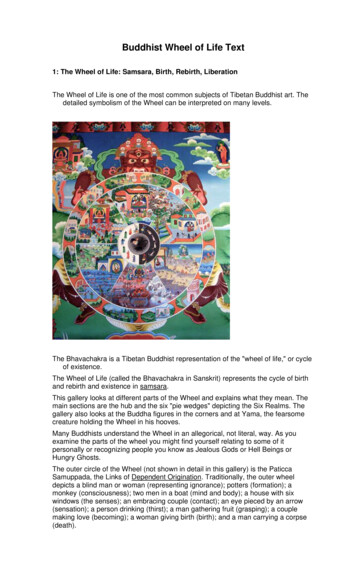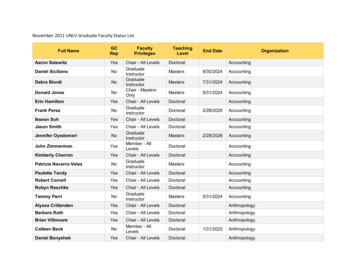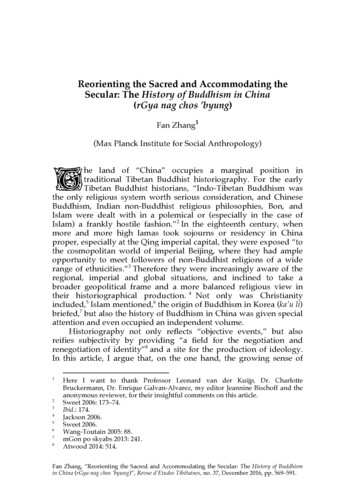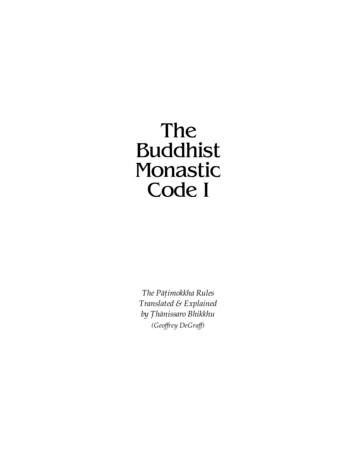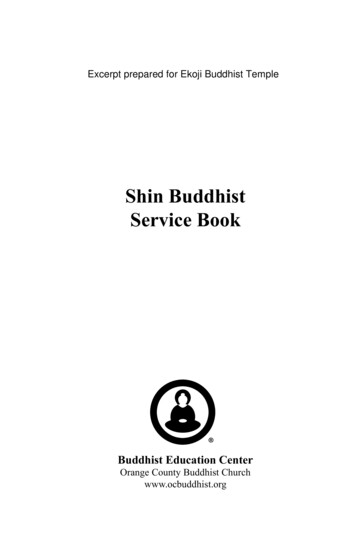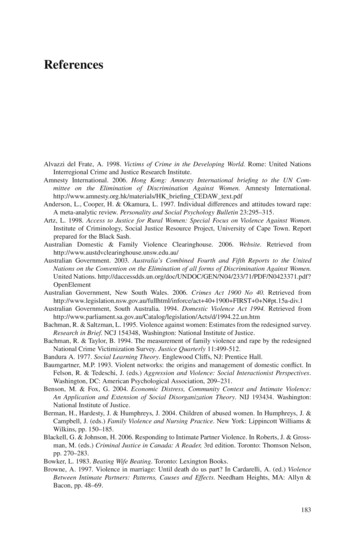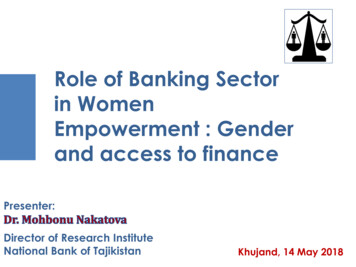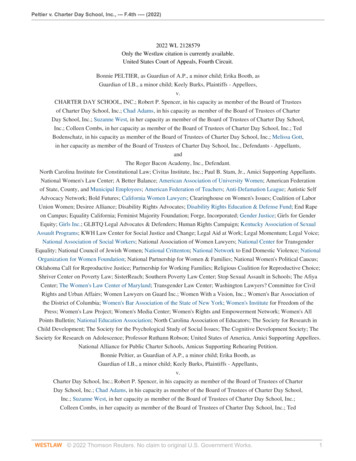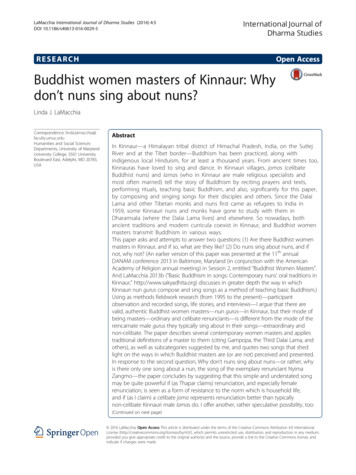
Transcription
LaMacchia International Journal of Dharma Studies (2016) 4:5DOI 10.1186/s40613-016-0029-5International Journal ofDharma StudiesRESEARCHOpen AccessBuddhist women masters of Kinnaur: Whydon’t nuns sing about nuns?Linda J. LaMacchiaCorrespondence: linda.lamacchia@faculty.umuc.eduHumanities and Social SciencesDepartments, University of MarylandUniversity College, 3501 UniversityBoulevard East, Adelphi, MD 20783,USAAbstractIn Kinnaur—a Himalayan tribal district of Himachal Pradesh, India, on the SutlejRiver and at the Tibet border—Buddhism has been practiced, along withindigenous local Hinduism, for at least a thousand years. From ancient times too,Kinnauras have loved to sing and dance. In Kinnauri villages, jomos (celibateBuddhist nuns) and lamas (who in Kinnaur are male religious specialists andmost often married) tell the story of Buddhism by reciting prayers and texts,performing rituals, teaching basic Buddhism, and also, significantly for this paper,by composing and singing songs for their disciples and others. Since the DalaiLama and other Tibetan monks and nuns first came as refugees to India in1959, some Kinnauri nuns and monks have gone to study with them inDharamsala (where the Dalai Lama lives) and elsewhere. So nowadays, bothancient traditions and modern curricula coexist in Kinnaur, and Buddhist womenmasters transmit Buddhism in various ways.This paper asks and attempts to answer two questions: (1) Are there Buddhist womenmasters in Kinnaur, and if so, what are they like? (2) Do nuns sing about nuns, and ifnot, why not? (An earlier version of this paper was presented at the 11th annualDANAM conference 2013 in Baltimore, Maryland (in conjunction with the AmericanAcademy of Religion annual meeting) in Session 2, entitled “Buddhist Women Masters”.And LaMacchia 2013b ("Basic Buddhism in songs: Contemporary nuns' oral traditions inKinnaur," http://www.sakyadhita.org) discusses in greater depth the way in whichKinnauri nun gurus compose and sing songs as a method of teaching basic Buddhism.)Using as methods fieldwork research (from 1995 to the present)—participantobservation and recorded songs, life stories, and interviews—I argue that there arevalid, authentic Buddhist women masters—nun gurus—in Kinnaur, but their mode ofbeing masters—ordinary and celibate renunciants—is different from the mode of thereincarnate male gurus they typically sing about in their songs—extraordinary andnon-celibate. The paper describes several contemporary women masters and appliestraditional definitions of a master to them (citing Gampopa, the Third Dalai Lama, andothers), as well as subcategories suggested by me, and quotes two songs that shedlight on the ways in which Buddhist masters are (or are not) perceived and presented.In response to the second question, Why don’t nuns sing about nuns—or rather, whyis there only one song about a nun, the song of the exemplary renunciant NyimaZangmo—the paper concludes by suggesting that this simple and understated songmay be quite powerful if (as Thapar claims) renunciation, and especially femalerenunciation, is seen as a form of resistance to the norm which is household life,and if (as I claim) a celibate jomo represents renunciation better than typicallynon-celibate Kinnauri male lamas do. I offer another, rather speculative possibility, too:(Continued on next page) 2016 LaMacchia. Open Access This article is distributed under the terms of the Creative Commons Attribution 4.0 InternationalLicense (http://creativecommons.org/licenses/by/4.0/), which permits unrestricted use, distribution, and reproduction in any medium,provided you give appropriate credit to the original author(s) and the source, provide a link to the Creative Commons license, andindicate if changes were made.
LaMacchia International Journal of Dharma Studies (2016) 4:5(Continued from previous page)that her name Nyima, meaning “sun”, may link her subliminally to reincarnate lamas,said to emit light rays.Keywords: Buddhism, Himalayan religion, Oral traditions, Women masters, Nuns,KinnaurBuddhist women masters of Kinnaur: Why don’t nuns sing about nuns?Kinnaur is a Himalayan district of Himachal Pradesh, northwest India, on the SutlejRiver at the Tibet border. Kinnauras have practiced Tibetan Buddhism, along with indigenous local Hinduism, since the great translator Lotsa Rinchen Zangbo built temples in Kinnaur in the tenth century. One of my informants pointed out that thismeans, because jomos and lamas are needed to keep the temples open, there musthave been jomos and lamas in Kinnaur for at least a thousand years. Jomos are celibateBuddhist nuns, ordained or not, and in Kinnaur the word lama refers to male religiousspecialists, who are typically married. Some lamas are reincarnates (tulkus in Tibetan),but no jomos are. From ancient times, as recorded in Sanskrit literature, Kinnaurashave loved to sing and dance, and because Kinnauri is an oral and not a written language, singing oral traditions is an important way to transmit news, history, andBuddhist teachings. In general, women are the composers and singers of Kinnauri language songs (gitang), and nuns compose and sing religious gitang. In contrast, Tibetanand Kinnauri male lamas may compose Tibetan language religious songs, calledmgurma.Though Kinnaur is an isolated tribal area, small (the size of Delaware), and sparselypopulated (little over 84,000 in 2011), it is of interest for us here not only because of itslong Buddhist history, rich oral traditions, and many jomos, but also because of its strategic location. In his 2009 book on Kinnaur, R. S. Pirta (2009: 28) writes: “a westernHimalayan community provides the perfect integration of global and regional issues. the Kanaoras have been a crucible for infinite social and cultural elements pouringfrom a vast region spanning from the north Indian plains to the Tibetan plateau”. Anda Kinnauri scholar expressed the opinion that since 1959 when the Dalai Lama andmany Tibetan followers came as refugees to India, Kinnaur has been at the center ofBuddhism and no longer at the periphery.Significant for this paper’s topic is the difficulty that Kinnaur’s geographic isolationcreates for nuns’ and monks’—but especially nuns’—access to education, both secular and religious. Until recently, a curriculum of advanced studies in Tibetan language,Buddhist texts, philosophy, and debate was not available in Kinnaur. Monks whowere able to left Kinnaur to study at monastic institutions in Tibet, and then later,when Tibetan refugees and the Dalai Lama came to live in India, at the monasteries that were reestablished in south India, Dharamsala, Nepal, and elsewhere. Notmany nuns were able to do so, owing mainly to nuns’ greater lack of resourcesand greater family obligations relative to monks. In recent years, two small nunneries that offer Buddhist studies programs have been established at Meeru and atPonda, both located in lower Kinnaur.This paper asks and attempts to answer two questions: (1) Are there Buddhistwomen masters in Kinnaur, and if so, what are they like? (2) Why don’t nuns singPage 2 of 13
LaMacchia International Journal of Dharma Studies (2016) 4:5about nuns? The answer to the first question is that there are and have been for a longtime Buddhist nuns who have been qualified ordinary women masters in Kinnaur. Thisis a plus for nuns. But the answer to the second question is that nuns do not usuallysing about ordinary masters. And so except for one song, about a model nun NyimaZangmo who was both an ordinary nun and probably taught other nuns as well, nunsdo not sing about nuns. In answering these questions, I will present examples of Buddhist women masters of Kinnaur as well as examples of the Dharma teaching songsthey sing. Using as methods fieldwork research in India from 1995 to the present—inthe form of journal notes, participant observation, life stories, interviews, and recorded songs—and also using traditional Tibetan Buddhist textual definitions andadditional categories that I propose, I argue that there are valid, authentic Buddhistwomen masters—nun gurus—in Kinnaur, but their mode of being masters—as ordinary teachers and celibate renunciants—is different from that of the reincarnate malegurus they typically sing about in their songs—extraordinary teachers and typicallynon-celibate. (For an account of nun gurus and disciples in Kinnaur, see alsoLaMacchia 2008. For an account of Buddhist nunneries in Himachal Pradesh, seeNguyen Thuy Tien 2010.)Part I defines a Buddhist master using traditional definitions as well as my suggestedthree subcategories that apply to Kinnaur. Part II presents examples of contemporaryBuddhist women masters of Kinnaur. Part III presents two songs that shed light onnun gurus’ roles and self-perceptions. Part IV attempts to explain why nuns don’t singabout nuns, and also, in conclusion, suggests why the one song about a named nun inKinnaur might be so popular.Gender issues and relations between nuns and monksThe two questions this paper poses in turn raise issues of gender status and of the relations between monks and nuns that are too complex to go into in any depth here. Inbrief, Kinnauri Buddhist institutions and practices are patriarchal and hierarchical.Most often the village hierarchy puts male lamas at the top; for example, male lamasmay occupy the foremost seats in a group ritual that includes both monks and nuns, amale lama will lead the ritual, and the village head lama is always male. But also, mostoften, male lamas, both married and celibate, work closely with nuns. In daily life, nunsand male lamas often perform rituals together. Male lamas are nuns’ relatives, theirbrothers, cousins, uncles, fathers, and sometimes nuns’ teachers. And nuns are malelamas’ relatives, their sisters, cousins, aunts, and sometimes monks’ teachers too, typically when the monk or male lama-to-be is young. For example, in Lippa, a DrukpaKagyu village in central Kinnaur, the contemporary nun Hirmal (see below) was taughtby her father (a former monk who studied in Tibet), and in turn she taught all theyoung male lamas-to-be in her village. Later, she taught her father’s tulku before hewent to Sikkim to study. On the other hand, although most often the relations betweenmonks and nuns are cooperative rather than competitive, laypeople may be more judgmental about nuns than about male religious specialists. A nun told me that laywomenwould not sing about a good ordinary nun, but they would sing about a nun if shebroke her vows, that is, got married. For example, in the popular courtship song, theSong of Sonam Dupke, a male lama of Lippa Village persuades his nun cousin to giveup her vows and marry him.Page 3 of 13
LaMacchia International Journal of Dharma Studies (2016) 4:5A discussion of gender issues would also need to consider other Kinnauri culturaland religious contexts. For example, in the local religion of Kinnaur, the cult of thedevi-devta (goddess-god), which Kinnauri Buddhists also subscribe to, the goddessChandika is regarded as most powerful. Although only men, no women, form the retinues of village gods and goddesses, Chandika is ranked senior to the other gods andgoddesses, who are her siblings. Another issue to consider is polyandry, which wascommon until recently in Kinnaur. This marriage system, in which several men, usuallybrothers, share one wife, seems to allocate more power to the wife than do other marriage systems, such as polygyny and monogamy.Greater access to education will bring change. It is too soon to know how monks andnuns’ roles and relative authority will be affected by advanced monastic education,which only has become available to women in recent years. The Kinnauri nuns in thefirst group of nuns who will become advanced monastic degree holders (geshemas) willonly complete their exams and be awarded their degrees in 2016 and subsequent years,so they have not yet returned to Kinnaur. It remains to be seen whether they willaccept teaching positions outside Kinnaur, in the larger monastic institutes for nuns, orwhether there will be a demand for their teaching expertise in Kinnaur. (For gender issues related to Buddhist nuns elsewhere, see Salgado 2013.)I. DefinitionsWhat is a Buddhist master? In Sanskrit and Hindi, a guru (Tibetan: bla-ma) is a spiritualteacher, a person with some degree of mastery of Buddhist knowledge and practices. She/hemay also be a meditation master. She is not the same as a saint (or siddhi) but can be.She/he may be a lay practitioner or a renunciant of the settled monastic type or of the forestwandering type (to use what Reginald Ray 1994 calls the “threefold model”).Tibetan Buddhist texts note that masters are of many types and that their specificcharacteristics and qualities differ according to school, sect, and level of teachings. Asthe Third Dalai Lama (16th century) wrote in Essence of Refined Gold: “In general, thequalities of the various masters of the Hinayana, Mahayana, and Vajrayana methods aremanifold” (Mullin 1987: 62). The current Dalai Lama comments on this: “In general,the more powerful the method being applied, the more qualified must the teacher be.For instance, one must rely upon a guru who is a fully enlightened Buddha in order toengage successfully in the final yogas of the Highest Tantra, whereas a disciplerequiring guidance through the lower instructions basically only needs to searchfor someone well grounded in scriptural learning and insight into the relevantpractices” (Mullin 1987: 59).The Third Dalai Lama lists these six basic qualifications of a master: training in 1)ethics, 2) concentration, 3) wisdom, and 4) scriptures. 5) Number 5 states that the master must have an “awareness that can perceive emptiness”. 6) But number 6 seems tomodify this difficult requirement by saying that at least the teacher “should have morelearning and realization than does the disciple” (Mullin 1987: 62).In the Jewel Ornament of Liberation, Gampopa (12th century) classifies spiritual masters into four categories (1998: 71): 1) ordinary spiritual master; 2) bodhisattva spiritualmaster who has attained certain bhumis (or “grounds”); 3) Nirmanakaya spiritual master;and 4) Sambhogakaya spiritual master. Significantly for my argument here—that there areand for a very long time have been Buddhist women masters in Kinnaur—GampopaPage 4 of 13
LaMacchia International Journal of Dharma Studies (2016) 4:5concludes that the “ordinary” master is most beneficial: “By meeting ordinary spiritualmasters, receiving the light of their teachings and shining it on the path, one will gain theopportunity to see the superior spiritual masters. So therefore, the greatest benefactor forus is the ordinary spiritual master” (1998: 72; my italics).Holding the bodhisattva vow is also important for a spiritual master. Gampopa’stranslator, Konchog Gyaltsen, explains: “[I]f the spiritual master has received bodhicittavows, has practiced it for some time, and cherishes it , then he [sic] may be trustworthy even if he [sic] is not a scholar or very articulate” (Gampopa 1998: 21).Today’s large monastic institutions may have several categories of master. GeorgesDreyfus lists the four types specified at the Institute of Buddhist Dialectics in Dharamsala,India (where he studied for the geshe1 degree, which he completed in 1985): 1) rootteacher, also called residence teacher or worldly teacher; 2) scholastic or text teacher; 3)tantric guru; and 4) spiritual friend (Sanskrit, kalyanamitra). Even worldly teachers can beclassified as guru, he says, because they too give spiritual instruction. The relationshipwith all of them is personal, and students may even live with the teacher, but only the tantric guru is “given quasi-divine status” (Dreyfus 2003: 61).Three subcategories of ordinary women masters in KinnaurIt is useful to see that nun gurus in Kinnaur meet the qualifications for Buddhist masters specified in traditional authoritative definitions. But if we look at actual nunteachers in Kinnaur, we can see differences among them. Taking Gampopa’s first category, “ordinary spiritual masters” as a reference point, I would like to propose threesubcategories of Buddhist women masters in Kinnaur, based on the level of studyreached by the master; for example, the teaching methods that are used, the subjectsthat she is able to teach, and who her students are, as follows:1) A typical traditional village nun guru;2) A highly respected village nun guru, one possessing special skills; and3) A nun guru with advanced secular or monastic degree (i.e., Ph.D. or geshe degree).All of these are considered to be “ordinary” Buddhist masters. In part II, below, I willgive examples of nuns who fit these subcategories. (Note that in defining a guru anddiscussing the guru-disciple relationship, these other sources may also be useful:Lempert 2012; Sopa 2012; Wach 1988; and Yogananda 1985).II. Examples of nun gurusWho are the Buddhist women masters of Kinnaur and how do these definitions andcategories of Buddhist masters apply to them? My first two examples are Chosem Dolmaof Bure Village (lower Kinnaur) and Upal Devi of Kanum Village (central Kinnaur).2 I metboth of them in 1996 and stayed at their village nunneries for several days at a time, thatyear and over the years since then. Both belong to the previous generation of nuns, and thedisciples of both have now completed their monastic studies and started to teach youngernuns. I recorded their life stories in 1996. (Chosem Dolma spoke to me in Hindi, which Ican speak; Upal Devi spoke in Kinnauri, with her nephew, who is a university professor,translating). I have also interviewed several of their disciples at nunneries where they arestudying, and also teaching, in Dharamsala (where the Dalai Lama lives) and in Kinnaur.Page 5 of 13
LaMacchia International Journal of Dharma Studies (2016) 4:5The two nun gurus have much in common: they both gave their nun disciples a firmfoundation in reading Tibetan, memorizing and reciting texts, and understanding basicBuddhism. Both nuns were the head of their village nunneries—Upal until she diedthree years ago3 and Chosem Dolma still is. In both cases, most of their disciplesleft—typically after seven or eight years (several after twenty years)—to pursue advanced studies in Dharamsala and elsewhere in a modern monastic curriculum (the fivegreat texts and so on; see Dreyfus 2003), some up to the geshe level. Their discipleshave stayed in touch by phoning and visiting even after leaving many years ago; theystill speak of their gurus’ “good character” and “good discipline” and of all that theylearned from them. Significantly, Chosem calls her disciples sati (companions) not disciples (chela), because she says her knowledge is not much more than theirs. Both nungurus struggled to get a Buddhist education, which was not easy in Kinnaur at thattime, and faced many obstacles. Both composed or sang gitang as one method of teaching basic Buddhism. Both were ordained as novice nuns (or getsulma, the highest levelavailable for women in the Tibetan Buddhist tradition, even today). Both are creditedwith other special achievements, too. In Chosem Dolma’s case, she was said to havesingle-handedly restored Buddhism to her village when it was in decline, by teachingthe young nuns from surrounding villages who came to live with her, and by buildingthe first Buddhist temple in her village, using her own land, resources, and labor. Inher life story, she recalled:At 12 or 13 years Negi Rinpoche-ji came to our house [ji is a Hindi honorific].Rinpoche-ji asked me, ‘Is the hair to be cut or not?’ Then I said, ‘Take it off.’ afterthat I went looking for Negi Rinpoche in Benares. At that time I was about 17 or 18.In this way, bit by bit, with much difficulty I began to read [Tibetan] a little bit .Then, meanwhile, from Tibet, the Dalai Lama arrived in Dharamsala. Then I went onpilgrimage to Bodh Gaya, Benares, Dharamsala, to Upper Kinnaur If some pilgrimscame, I’d go with them. After that a little understanding came to me. When understandingcame, I was already 25 years old. When I was 25, having gone to Dharamsala I became aRabchungma first Genyen then Rabchung, then Getsulma vows he gave.4Inspired by Tibetans who were building houses and temples in Dharamsala aroundthe Dalai Lama, Chosem Dolma determined to build a Buddhist temple, using her ownfamily resources, in her mostly Hindu village. But the other villagers criticized her, shesaid: “No one gave money. No one told me how to do it. No one helped me. And thevillagers said, ‘What did she build? Why did she do this? Where did she get the money?Who is giving it?’” (LaMacchia 2008: 196.)In Upal Devi’s case, she and two nun companions, called Siam and Boti, traveled onfoot to Tibet—an arduous journey of several months through high, cold mountainpasses—to seek teachings from monks at Tashi Lhungbo monastery. Before the Chinesetakeover, Tashi Lhungbo had a connection to Kinnaur since many Kinnauri monks hadstudied there. But such an undertaking was unusual for nuns, and the monks refusedto teach her. (She said later that their refusal was more painful than all the frostbiteand other hardships she had experienced on her journey to Tibet; see LaMacchia2008: 189.) So instead, she studied for three years with nuns at a nearby nunnery.The teachers there did not teach her philosophy and logic, but she did learn TibetanPage 6 of 13
LaMacchia International Journal of Dharma Studies (2016) 4:5from them, learned how to read it, and memorized Tibetan prayers and texts beforereturning to Kanum. There she devoted the rest of her life to teaching and supportingthe nuns in her village nunnery.What kind of masters are these two nun gurus of Kinnaur? Using the third DalaiLama’s sixth qualification, both teachers had “more learning and insight into the subjectconcerned” than their disciples did. Using Dreyfus’s categories, the nun gurus ofKinnaur belong to categories number 1, 2, and 4—residence teachers, text teachers,and spiritual friends—but not to category number 3; they are not tantric gurus. Mostencouragingly, in Gampopa’s terms, they are “ordinary spiritual masters”, which he describes as the greatest benefactors for us beginners on the Buddhist path. I don’t knowwhether Chosem Dolma and Upal Devi had formally taken the bodhisattva vows—oneof Gampopa’s requirements. But both of them devoted their lives to helping others, notonly running the nunnery and teaching their own disciples but also counseling all thoselaywomen and others who came to them with problems. In terms of the three subcategories proposed by me, Chosem Dolma and Upal Devi belong to the first subcategory.Chosem Dolma and Upal Devi are examples of a typical traditional village nun guru.Applying the three subcategories to Buddhist women masters of KinnaurIn category 1, a typical village nun guru, the definition fits both of the above two examplesdescribed in this paper so far: Chosem Dolma and Upal Devi. They taught their ownvillage jomos, plus jomos from nearby villages, and they advised lay women who came tothem (and in Chosem Dolma's case, still come) with problems. They taught their studentshow to read, memorize, and recite Tibetan texts, prayers, and rituals. They taught basicBuddhism topics, such as impermanence, suffering, karma, rebirth in the six realms, andtaking refuge in the guru, Buddha, Dharma, and Sangha (see LaMacchia 2013b). In termsof teaching methodology, their style was traditional: their students practiced reading byreciting out loud and memorizing. Another method, particular to Kinnauri nuns, is tocompose and sing Kinnauri language songs (called gitang) to teach the Dharma. Not allvillage nun gurus do this, but Upal Devi and Chosem Dolma did.In category 2, a highly respected village nun guru with special skills, suitable examples areHirmal Jomo of Lippa Village and Spello Jomo Chattan Mani (d. 1996) of Spello Village.Spello Jomo had the reputation of being both a good scholar and a good practitioner. Forexample, Khenpo Thupten Wozer, abbot of a hermitage near Manali, praised her ability toanswer questions about both philosophy and history. Interestingly, she also sang the songsof Milarepa as a form of Dharma teaching. She had studied and practiced in Tibet for fiveyears with the lama scholar Kyunglung, who mentions her in his autobiography. She alsoreceived complete ordination (gelongma) from him (see LaMacchia 2012). Her nun disciplespraised her practice of Chod, and the speed at which she could recite the ritual. She alsogave the Nyungne (fasting) vows to villagers. One of her disciples compared her explanations of Nyungne to the Dalai Lama’s public talks. Notably, one of her students was a monkfrom outside Kinnaur, to whom she taught Shantideva’s text Bodhicaryavatara. When themonk translated the work into Hindi and published it, he acknowledged his teacher ChattanMani in the foreword (Shantibhikshushastri, tr. 2011).Hirmal’s father had been a monk scholar, and he had passed on his knowledge to hisonly child, Hirmal. So she could not only teach her students how to read Tibetan texts,but she could also teach her students Tibetan grammar and how to write Tibetan. HerePage 7 of 13
LaMacchia International Journal of Dharma Studies (2016) 4:5again, Hirmal sang songs, not Kinnauri language songs (gitang), but Tibetan languageDharma songs (mgurma). Indeed, at Losar when lamas and nuns danced in front ofthe village temple when I was there in winter of 2010, Hirmal sang the sung-gur thatthey danced to (which I recorded). Hirmal had many nun disciples (who still continueto visit her many years later), and had taught all the lamas of Lippa when they wereyoung. She also taught her father’s tulku, before he went away to study in Sikkim.In category 3, a nun guru with advanced secular or monastic degree, there are very fewexamples. I know of one nun from Ropa Village who finished a Ph.D. in Sanskrit a few yearsago and afterwards was invited to teach overseas. Then there are the nuns who are in thefirst group of geshemas (female holders of geshe advanced monastic degrees), who have studied outside of Kinnaur for many years and are still in the process of taking their geshe exams.We will not know for some time where they will be teaching in the future and to whom.III. Two songsThe following songs demonstrate the contrasting ways in which a jomo-guru and alama-guru are presented. Both songs were sung in Kinnauri by middle-aged nuns in1995, recorded by me, and transcribed and translated by Professor Ramesh ChandraNegi (Mathas). Since that time, nuns from different parts of Kinnaur have sung fourmore versions of the song of Nyima Zangmo for me (one less than three years ago, in2013). The singer of this example, Tenzin Choeden of Hango Village, sang the song forme near Manali at Pangaon Hermitage. She did not know who the song’s composerwas and had learned it from her “great grandmother” (possibly a senior village nun),she said in Tibetan, with a young nun from Bhutan translating. Here is her song:The song of Nyima Zangmo51. “Goli go hona, haya be hona. [Kinnauri songs traditionally begin with thesemeaningless syllables.]2. If we go to the lower side, we will reach Tashi Gang temple.3. There, lamas and jomos are gathered.4. What type of meeting is going on?5. At that meeting they said, ‘We will build a temple.’6. On the foremost seat of the lamas,7. We can see Brother Changzod Chenmo.8. On the foremost seat of the jomos, we can see Sister Nyima Zangmo.9. Nyima Zangmo said, ‘Brother Changzod Chenmo!10. I will become a jomo.’11. Changzod Chenmo said, ‘Beautiful Nyima Zangmo!12. You cannot become a jomo.13. You are a rich man’s daughter.14. You have many ornaments.’15. Nyima Zangmo said, ‘I am not proud of my ornaments.16. They will only be a burden in the next life’”.This song is widely known in Kinnaur, and it is the only song I have recorded (amongmore than thirty songs sung by nuns) whose focus is renunciation and whose subject isPage 8 of 13
LaMacchia International Journal of Dharma Studies (2016) 4:5a particular, named nun. One purpose of Kinnauri language songs (says ProfessorRamesh Chandra Negi) is to pass on some news. Newsworthy here is, first, that thoughNyima Zangmo is rich, beautiful, and marriageable, and despite family opposition, sheis determined to become a nun. The next news: she does become a nun and even headnun, “on the foremost seat”. The third news is the purity of her renunciation: (1) Hermotive relates to karma, cause and effect, and her goal is a good rebirth. (2) She is notbecoming a nun for secular reasons such as security, a motive laypeople may accusejomos of having. (3) Instead, she says, living a worldly life (wearing jewelry) won’t helpher in the next life (implying that becoming a jomo, by removing jewelry among otherthings, will help). Finally, though the song does not say this, as the head nun, she probably taught the younger nuns. So she was an “ordinary” (see above) good nun and Buddhist master.Note that the meaning of the nun’s name, Nyima, is “sun”, which could link her tolamas who emit rays of light in the songs sung about them, such as the one that follows. It would be interesting to explore the significance of her name in relation to thepopularity of her song, although so far I have heard only literal explanations thatplace Nyima Zangmo in a particular historical context, for example, that she was bornto a wealthy family in Leo Village and that her brother Changzod Chenmo was thevillage head lama. It would be difficult to prove that the symbolic resonances of hername are factors in the song’s popularity, insofar as the singers themselves are notaware of these resonances.The nun guru Chosem Dolma (see above) had composed this next song exampletwenty years earlier and in 1996 sang it for me in Bure Village. The song containsmany Tibetan words related to
Departments, University of Maryland University College, 3501 University Boulevard East, Adelphi, MD 20783, USA Abstract In Kinnaur—a Himalayan tribal district of Himachal Pradesh, India, on the Sutlej River and at the Tibet border—Buddhism has been practiced, along with indigenous local Hinduism, for at least a thousand years. From ancient .
